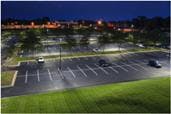The company and its employees were immediately impressed with the results of the outdoor area lights. "The aesthetics were amazing—we saw one lot that was half complete, and the difference from one side to the other was incredible. There were no dark spots where GE’s area lights had gone in," said Richard DeRick, portfolio manager for Cushman & Wakefield, which manages 7.3 million ft2 of space for MetLife.
With GE's Evolve LED area lights, MetLife will now use nearly 1.1 million fewer kWh to illuminate its parking lots—equaling a $164,000 utility cost savings per year (based on a $0.15 kWh rate and 4380 hours of operation).
The partnership between MetLife and GE started when John Chambers, MetLife's assistant VP of facility services and sustainability, met with GE Lighting's LED outdoor lighting experts.
"We decided to have them perform a test for us," says Chambers. "We installed several fixtures at one of our Pennsylvania properties and were very impressed with the improved visibility in the lot. That’s when we made a multi-site upgrade part of our critical plan for the coming year."
Starting in early 2010, MetLife began replacing existing high-pressure sodium (HPS) and metal halide parking lot lights at eight administrative facilities and two data centers in several states (containing an average of 700 parking spaces and 100 fixtures) with GE’s ecomagination Evolve LED area lights.
"It was a seamless, easy transition from the old lights to the new LEDs," said DeRick."The electricians had no problem with the footprint of the base going on the existing poles."
MetLife says that it anticipates much less maintenance for many years because GE’s Evolve LED area lights are expected to significantly outlast the old lights. Previously, up to 25% of the old HID lamps had to be changed each year, incurring tens of thousands of dollars.
Indoor lighting changesThus, nearly 13,000 GE F28 T8 linear fluorescent lamps were installed at the St. Louis office. The new LFL design also uses more than 8000 GE UltraStart Programmed Start (PS) ballasts and a few UltraStart dimming ballasts. The ballasts provide a "soft start" that can significantly extend lamp life opposed to standard instant-start ballasts. They also provide greater energy-savings potential when integrated with occupancy sensors, daylight harvesters or other automated light controls.
MetLife expects to invest its energy savings back into the system, possibly adding photo cells, motion sensors, and control options. Chambers noted total project payback will take less than five years for the new LED-lit parking lots and a little more than two years in St. Louis.








